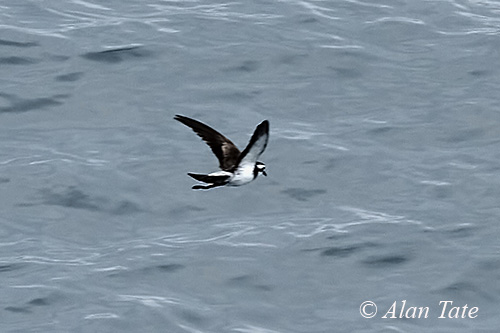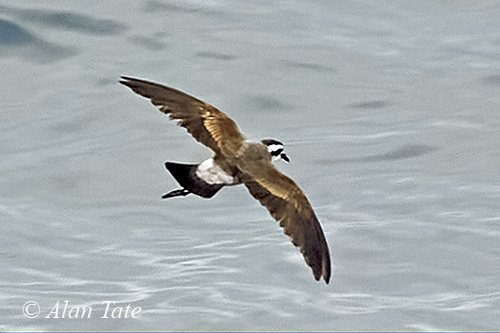
PROTECTION / THREATS / STATUS:
The White-faced Storm-Petrel is extremely vulnerable to invasive predators on land which are the main cause of hatching failure. These predators are mice (Mus musculus), rats (Rattus species), cats (Felis catus), owls (Strigidae), the Weka, skuas (Stercorariidae), large gulls of genus Larus (Laridae), snakes, land crabs…
Plastic contamination is also a problem, but the impact on this species is not well known.
The global population is estimated to number at least 4,000,000 individuals. This population is suspected to be declining owing to predation by various species as described above.
But the species is not considered globally threatened at the moment, and currently, the White-faced Storm-Petrel is evaluated as Least Concern.
Fr: Océanite frégate
Ang: White-faced Storm-Petrel
All: Weißgesicht-Sturmschwalbe
Esp: Paíño Pechialbo
Ita: Uccello delle tempeste facciabianca
Nd: Bont Stormvogeltje
Sd: fregattstormsvala
Photographers:
Alan & Ann Tate
AA Bird Photography
Text by Nicole Bouglouan
Sources:
HANDBOOK OF THE BIRDS OF THE WORLD vol 1 by Josep del Hoyo-Andrew Elliot-Jordi Sargatal - Lynx Edicions - ISBN: 8487334105
Revealing the foraging movements and diet of the White-faced Storm Petrel Pelagodroma marina in the NE Atlantic
The breeding biology of the White-faced Storm Petrel (Pelagodroma marina) on Mud Islands, Port Phillip Bay, Victoria
BREEDING HABITATS OF THE WHITE-FACED STORM PETREL (PELAGODROMA MARINA) IN EASTERN BASS STRAIT
South Dakota Birds and Birding – (Terry L. Sohl)
Wikipedia, the free encyclopaedia
White-faced Storm-Petrel
Pelagodroma marina
Procellariiformes Order – Oceanitidae Family
INTRODUCTION:
The White-faced Storm-Petrel is the only member of the genus Pelagodroma in the austral storm-petrel family Oceanitidae. Six subspecies share the wide range through subtropical to subantarctic regions of the Atlantic, Indian and SW Pacific Oceans.
The White-faced Storm-Petrel is a pelagic species usually found near the edge of the continental shelf and over upwelling currents in the very deep water beyond.
They breed on remote islands, in colonies established in rock crevices close to the sea, and nest in burrows dug under the dense vegetation. Outside of the breeding season, they spend the rest of the year at sea.
Their diet includes crustaceans, small fish and squid, sea-skaters (Halobates) and marine insects. They feed on the wing by pattering, dipping and surface-seizing.
The White-faced Storm-Petrel is affected by predation by invasive species, especially mice, but also by plastic contamination. The population is declining, although not globally threatened at the moment.
DESCRIPTION OF THE BIRD:
Biometrics:
Length: 18-21 cm
Wingspan: 38-45 cm
Weight: 40-68 g
The White-faced Storm-Petrel is a medium-sized seabird. The upperparts are brown-grey from hindneck to upper rump, whereas lower rump and uppertail-coverts are pale grey. On the upperwing, the coverts are brown-grey. The greater coverts show pale tips forming a narrow whitish wingbar. Both flight-feathers and rectrices are blackish.
On the white underparts, the broad, partial brown-grey collar is present on neck sides. Both flight-feathers and rectrices are dark grey to blackish. The leading edge is blackish.

On the head, crown, nape and facial mask are dark brown-grey. The mask extends from eye to rear of ear-coverts, and contrasts with the white face including the forehead, the cheeks and a long broad supercilium. Chin and throat are white too.
The bill is black. The eyes are dark brown. Legs and feet are blackish but the webs are pale yellow.
Male and female are similar, but the female has larger wings and tail.
The juvenile resembles adult with some variations according to the moult.
SUBSPECIES AND RANGE:
The White-faced Storm-Petrel has six subspecies, separated by slight differences in size, proportions and coloration.
P.m. marina (described above) is found in S Atlantic Ocean. It breeds at Tristan da Cunha and Gough Island, and the race is also recorded at St Helena where it breeds.
P.m. hypoleuca occurs in N Atlantic Ocean. It breeds in Savage Islands and Canary Islands.
P.m. eadesorum breeds in Cape Verde Islands.
This race has white collar on hindneck and more white on forehead.
P.m. dulciae is found in N Indian Ocean to SW Pacific Ocean. It breeds in W and S Australia, on islands off S Australia and Tasmania.
P.m. maoriana is found in tropical E Pacific Ocean, and breeds in several islands off New Zealand, including Stewart Island, Auckland and Chatham Islands.
This race may have a complete breast band.
P.m. albiclunis is found in Tasman Sea and breeds at Kermadec Islands.
HABITAT:
The White-faced Storm-Petrel is strictly pelagic outside of breeding season. It comes ashore only on small remote islands where it breeds.
The species nests in burrows, often in flat, sandy areas with low herbaceous vegetation. It may also nest in rocky areas and on slopes.
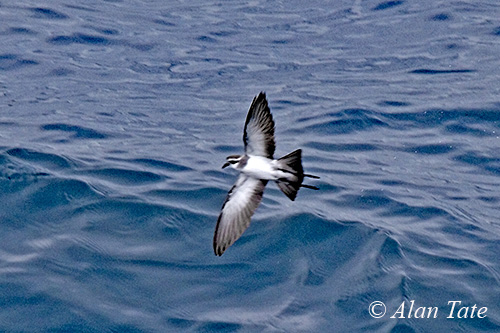
CALLS AND SONGS: SOUNDS BY XENO-CANTO
The White-faced Storm-Petrel is silent at sea, but while on the ground at the breeding colonies, it gives cooing calls. We can hear mournful “woooo” or “ooo-aaa-ooo” also given from inside the burrow.
They produce soft squeaking sounds (audible in calm weather conditions) when foraging in groups at sea. However, they are silent when flying over the colonies at night, to avoid predation.
BEHAVIOUR IN THE WILD:
The diet of the White-faced Storm-Petrel includes primarily small fish and cephalopods, and especially Lanternfish of family Myctophidae. It also consumes planktonic crustaceans of various species, and other surface plankton, some squid, sea-skaters (Halobates) and fast-moving marine insects.
The population of the Chatham Islands feeds mainly on crustaceans (70%), and fish (30%), picked up from water surface.
The White-faced Storm-Petrel feeds on the wing by pattering, dipping and surface-seizing. It may flop into the water but it dives only exceptionally, probably when disturbed or threatened.
This species rarely follows ships, but it may feed close to stationary vessels. They also follow cetaceans, and feeding flocks of up to 2,000 birds are reported.
It feeds mainly in deep oceanic waters, up to 400 km from the colony. Some of them also forage along the edge of the shelf, especially during the chick-rearing period.
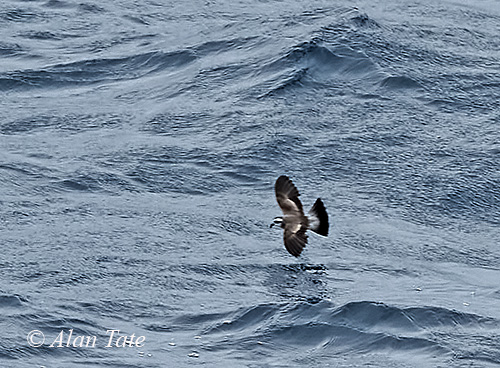
The White-faced Storm-Petrel is monogamous and breeds in dense colonies established on remote islands. It nests in burrows dug in soft soil, protected by vegetation. They are active at night and both adults share the nesting duties.
The White-faced Storm-Petrel is migratory or dispersive depending on the range.
The nominate race P.m. marina disperses E to Africa (S to South African waters) and W towards South America.
But outside of breeding season, all races are found in pelagic areas, much of the Southern Pacific, Indian and Atlantic Oceans, as well as in the North Atlantic.
The White-faced Storm-Petrel flies low with an odd rocking motion. The wings are held out to the body sides, and the long legs are dropped, repeatedly pushing off against the water with the webbed feet.
The gliding flight is direct. While picking food items from water surface, the bird patters on the water as described above. On the ground, it only performs a short shuffle to the burrow, as its walking ability is limited.
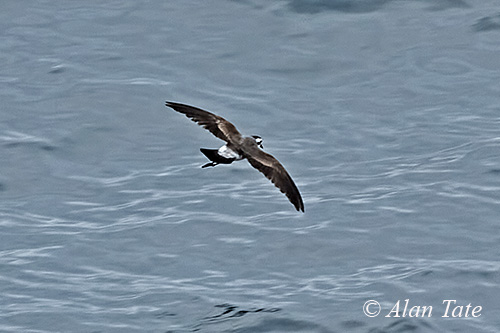
REPRODUCTION OF THIS SPECIES:
The White-faced Storm-Petrel usually breeds during local spring and summer, but the egg-laying period varies depending on the range.
The birds return to the colonies 6-7 weeks prior to laying and pre-laying exodus (about 14 days at least in females).
The colonies are established in rock crevices and close to the sea. The nesting burrow densities are influenced by plant species, vegetation height and soil moisture. The nesting burrow is short, sometimes as little as 30 cm long and only 5 cm in diameter at the entrance, but becoming broader into an underground nesting chamber.
From some observations in Bass Strait area, short pieces of Poa (Poaceae family) also named “Silver tussock” are dragged as nesting material.
But other burrows may consist merely of channels roofed by dense carpets of Tetragonia (Aizoaceae family) or other mat plants.
However, the burrows are generally 30-120 cm long, 4-5 cm height and 7-7,5 cm width. They are dug in soft soil and below vegetation. Dry material is used as lining. Densities of up to 1-5 burrows/m² are reported according to soil quality and vegetation density.
The female lays a single white egg finely spotted with brown and grey. Both parents share the incubation during 50-56 days, in stints of 3-5 days.
At hatching, the chick has pale grey down overall. It is usually brooded for the first 2-4 days. It is fed at night by the adults, with partly-digested paste of small fish and crustaceans. It fledges about 52-67 days after hatching. It gains the sexual maturity after at least 3 years.
The adults are strictly nocturnal at the colonies to avoid predation by gulls (Laridae) and skuas (Stercorariidae).
